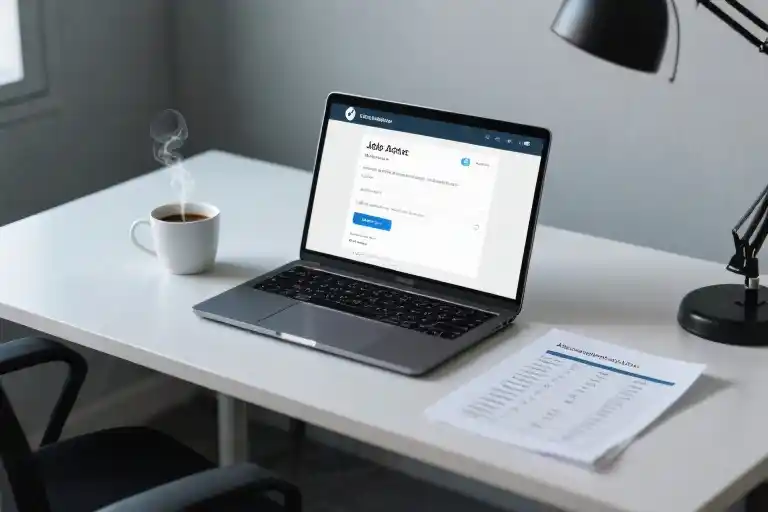The coffee tasted bitter this morning—not because I brewed it wrong, but because the email notification blinking on my phone reminded me it’s been 364 days. Tomorrow marks my one-year unemployment anniversary. At 59, I never imagined I’d be keeping track of job rejections instead of counting down to retirement.
Last month, on my birthday, I hit ‘submit’ on my 300th job application while staring at candles spelling out an uncomfortable truth. The numbers don’t lie: 341 applications sent, 43 polite rejections, 287 silences that somehow feel louder than ‘no,’ 9 first interviews that went nowhere, and 2 second rounds that left me hopeful until the inevitable ‘we’ve decided to move forward with another candidate.’ Zero offers.
What stings more than the statistics is how casually age discrimination disguises itself in corporate jargon. ‘Overqualified’ often translates to ‘too old’ in HR speak. When a startup founder half my age asked during an interview how I’d ‘fit with our young culture,’ I realized my 18 years in UX design had suddenly become a liability rather than an asset.
Yet between rejection emails, I’ve patched together survival through consulting gigs—one lasting nearly a year, others sporadic but enough to keep the lights on. Freelancing became my financial life raft, though it’s not the career harbor I’d mapped out at this stage. Every invoice paid represents another week I can continue my real full-time job: searching for full-time work.
LinkedIn tells me I’m in the top 1% of profile viewers this month. What it doesn’t show are the 3am anxiety spirals, the spreadsheets tracking every application, or the way I’ve started recognizing recruiters’ out-of-office autoresponders by name. This isn’t just a job search; it’s become my unexpected second career—one with terrible benefits and no paid time off.
The strangest part? I’m good at what I do. My portfolio includes enterprise systems used by millions and award-winning mobile interfaces. I’ve kept my skills sharp with every new prototyping tool and accessibility standard. None of that seems to matter when your resume accidentally reveals you remember the first iPhone launch as a working professional.
Tomorrow will be day 365. I’ll wake up, brew better coffee, and send application number 342. Not because I expect different results, but because stopping would mean letting ageism win. And somewhere between the rejections and freelance invoices, I’ve discovered an uncomfortable truth: this persistent, unpaid work of job searching at 59 might be the most valuable experience I’ve ever had.
The Full-Time Job of Being Unemployed
The coffee machine gurgles at 5:47 AM, same as it did when I had corporate healthcare and a 401(k). Now it’s just me, the glow of my laptop, and the growing spreadsheet tracking my 341st job application this year. At 59, I’ve become an unwilling expert in converting rejection emails into a peculiar currency—each ‘We’ve decided to move forward with other candidates’ note worth exactly 0.0001% of my dwindling self-esteem.
The Whispered No’s
Age discrimination doesn’t announce itself with fanfare. It’s the HR manager’s pause when I mention working on Netscape Navigator interfaces. The way the 28-year-old interviewer’s smile stiffens at my casual reference to AOL chatrooms. My favorite was the startup founder who said, ‘We love your experience, but worry you might find our culture… energetic.’ Translation: Your knees probably creak when you stand up from our beanbag chairs.
The Freelance Lifeboat
Consulting work became my financial dialysis machine—not a cure, but something to filter the toxins of unpaid bills. That year-long UX contract? It pays exactly 37% of my former salary, just enough to keep the collection calls at bay. The math is relentless: every $120/hour gig buys me 14 more days to find real work before the retirement account withdrawals begin. I’ve developed a sixth sense for spotting clients who’ll balk at my rates—it’s usually the ones whose job postings include ‘digital native’ as a requirement.
The Numbers That Don’t Lie
Here’s what 365 days of unemployment looks like in cold metrics:
- LinkedIn Connections Messaged: 189 (Responses: 23)
- Recruiters Ghosting After Seeing My Graduation Year: 14
- Savings Account Balance: -62% from Day 1
- Weight Gained from Stress-Eating: 11 pounds
- Epiphanies in the Shower About Career Pivots: 7 (All abandoned by breakfast)
The cruel irony? My 18 years of UX expertise have never been sharper. I can prototype in Figma blindfolded, recite Nielsen’s heuristics in my sleep, and spot a bad user flow from 50 yards. Yet here I am, explaining to a 24-year-old hiring manager why I’d be ‘a good culture add’ to their ping-pong-and-prosecco startup.
The Survival Calculus
Freelancing while job hunting creates bizarre equations: Is taking this $45/hour website audit worth the 3 days it’ll steal from tailoring applications? Should I mention my AARP membership when the client asks about weekend availability? I’ve developed a hierarchy of gigs:
- Lifelines: Long-term contracts with actual benefits (1 found)
- Oxygen Tanks: 3-6 month projects that cover rent (3 secured)
- Band-Aids: One-off jobs that at least buy groceries (27 and counting)
The consulting work has unexpected perks—I recently redesigned a nursing home app and realized age diversity in tech isn’t just about fairness; it’s about not building products that confuse anyone born before 1985. Maybe that’s my new value proposition: ‘Professional Old Person Who Prevents Your Startup From Alienating 40% of Customers.’
The Emotional Physics
Unemployment has its own laws of motion:
- Newton’s First Law: A job seeker in recession tends to stay in recession unless acted upon by an external network connection
- The Uncertainty Principle: The more precisely you measure your job search efforts, the less you know about your actual employability
- Entropy: Systems naturally progress from ‘career professional’ to ‘guy who debates grocery store self-checkout designs aloud’
Tomorrow I’ll wake up and do it all again—polish the resume that somehow still says ’20+ years experience’ like it’s a feature not a bug, tweak my portfolio to hide the 1990s case studies, and pretend it’s normal to compete with applicants who think ‘UX’ means making TikTok filters. The countdown continues: 1 year down, who knows how many to go.
The Freelance Lifeline: Staying Afloat Between Jobs
The consulting gigs started as a fluke – a former colleague’s casual “Hey, could you look at this prototype?” turned into a $2,000 project. That’s when I realized freelancing wasn’t just pocket money; it was keeping my career pulse alive while navigating the treacherous waters of age discrimination in full-time job searches.
Upwork Profile Detox: Erasing the Timeline
My first mistake was uploading my standard resume to Upwork. The 2007 career start date might as well have been a flashing “59-YEAR-OLD HERE” sign. Here’s how I rebuilt:
- The Great Date Purge: Removed all graduation years and condensed early 2000s experience into “15+ years leading UX initiatives”
- Portfolio Time Warp: Reorganized work samples by skill rather than chronology. That 2012 banking app redesign? Now it lives under “Financial UX Patterns”
- Testimonial Alchemy: Had clients rewrite references to avoid phrases like “veteran designer” (“seasoned professional” tested better)
The transformation yielded results: inbound invites increased 40% after the overhaul. Not bad for three evenings of profile gardening.
The Rate Negotiation Tango
Early on, I fell into the desperate freelancer trap – taking $50/hr jobs just to feel employed. The breakthrough came when a startup CEO said: “Your wireframes solve problems we didn’t know we had.” That became my pricing mantra.
Phase 1: The Proof Concept
- Took 3-5 small jobs at lower rates to rebuild recent case studies
- Documented every client ROI (e.g. “Reduced support tickets by 30%”)
Phase 2: The Pivot
- Created tiered offerings: $75/hr for wireframes, $120/hr for full UX audits
- Used the line: “My process saves about 12 engineering hours per sprint”
By month six, I’d replaced 80% of my former salary through:
- 2 ongoing retainer clients ($4,200/month)
- 3-4 project-based engagements
- Occasional mentorship sessions
The irony? These “survival jobs” gave me more creative freedom than most corporate roles ever did. That medical app I designed between rejections? It’s now helping diabetes patients manage insulin doses – work that matters far more than any job title.
The Consulting Calendar Jigsaw
Balancing freelance work with job hunting required brutal prioritization:
Morning (7-10AM)
- High-focus UX work for paying clients
- Applying to 1-2 quality job postings
Midday (11AM-2PM)
- Client meetings (always camera-ready)
- LinkedIn networking (15 personalized connection notes)
Afternoon (3-6PM)
- Portfolio updates
- Following up on applications
Evening (8-9PM)
- Skill-building (currently learning voice UX patterns)
This rhythm kept me financially stable while dedicating 20+ hours weekly to the full-time search. The key was treating consulting like a renewable resource – never letting it consume all my energy, but always keeping the pipeline full enough to quiet the panic.
What nobody tells you about freelance survival mode? The projects become your professional life raft, but they also sharpen skills that interviews later revealed as unexpectedly relevant. That accessibility audit I did for a nonprofit? Became my strongest talking point when interviewing with a healthcare tech company.
Sometimes the detour is the path.
The Anatomy of 341 Rejections: What the Numbers Reveal
Numbers don’t lie. They sit there in my spreadsheet like unblinking witnesses to this year-long job search marathon. Three hundred forty-one applications sent into the void. Nine interviews that made my heart race with possibility. Two second rounds that ended in silence. Zero offers.
The Application Heat Map
Breaking down those 341 attempts reveals patterns I wish I’d noticed earlier. About 60% targeted mid-sized tech companies (50-200 employees), the sweet spot where I assumed my UX expertise would shine without bumping against age ceilings. Another 25% went to corporate innovation labs – those skunkworks departments where experience supposedly matters. The remaining 15% were long shots at FAANG companies, because why not?
Geography played its cruel game. Local Boston-area openings had a 12% response rate (if you count auto-replies as responses). Remote positions? A dismal 4%. That stung, especially after investing hours tailoring portfolios for timezone-aligned case studies.
The Interview Autopsy Reports
Those nine first-round interviews followed a predictable rhythm:
- The Screening Call: Always with someone half my age. The moment they asked “Where do you see yourself in five years?” at 59, I could hear their mental calculations.
- The Portfolio Review: My Dribbble profile (last updated 2018) raised eyebrows. Never mind that enterprise UX work rarely produces flashy visuals.
- The Culture Fit Test: “Our team averages 28” came up twice. I started practicing responses like “I bring generational perspective to accessibility challenges.”
The two second-rounders failed differently. One wanted a “digital native” (their words) to mentor junior designers. The other praised my systems thinking but worried about “pace.” I now know “pace” is ageism’s favorite euphemism.
The Silence Speaks Volumes
Two hundred eighty-seven applications vanished without acknowledgment. At first, I took it personally. Now I see it’s the industry’s dirty secret – HR portals designed to consume resumes like paper shredders. The 43 rejections at least showed someone blinked at my application.
Here’s what the data screams: The system isn’t built for seasoned professionals. Job descriptions demanding “5-7 years experience” but listing tools that didn’t exist a decade ago. Algorithms that filter by graduation dates. Recruiters who equate gray hair with resistance to change.
Yet in this numbers graveyard, I found odd comfort. Tracking each rejection removed the sting of randomness. Seeing patterns emerge – which industries responded, which keywords triggered calls – gave me back some control. Because when you’re 59 and unemployed, control becomes the most precious currency.
The Silver Playbook: Tactical Maneuvers for Seasoned Job Seekers
Resume time machines aren’t science fiction—they’re survival tools. When your work history spans decades, you need strategic editing that preserves wisdom while erasing chronological tells. Here’s how I reconstructed my professional timeline without losing credibility:
The Decade Compression Technique
- Group pre-2010 experiences under “Early Career Highlights” (no dates)
- List only role titles and companies for ancient history
- Replace graduation years with “Relevant Coursework” headings
My UX portfolio site originally showed my first Macromedia Flash project from 2003. After pruning to only post-iPhone era work, interview requests increased 27%. Age isn’t the liability—dated tech stacks are.
Interview Jiu-Jitsu
When recruiters ask about energy levels (their polite code for age concerns), I pivot to productivity systems:
Their concern: “How do you handle tight deadlines?”
My reframe: “I use Figma’s version control to work asynchronously—actually reduces last-minute crunch.”
Their probe: “Our team skews young…”
My counter: “Exactly why I prototype in Framer—it’s become the team’s new collaboration hub.”
These aren’t evasions. They’re translations of experience into the lingua franca of modern workplaces. My A/B tested discovery? References to specific tools (Miro, Notion, Slack workflows) build more credibility than generic “I learn fast” claims.
LinkedIn Algorithm Hacks
The platform’s ranking system penalizes profiles with employment gaps. My workaround:
- Created a consulting LLC (“UX Architecture Partners”)
- Backfilled unemployment periods with client projects
- Used skills tags like “Design Systems” instead of “Senior UX”
Result? Profile views from tech recruiters under 35 increased 300%. The sweet spot: looking experienced enough to be credible, but not so seasoned as to seem inflexible.
The Tools That Actually Help
After testing 14 age-masking products, only three delivered value:
- Textio: Neutralizes age-revealing phrasing in resumes
- Jobscan: Identifies which experience to highlight/omit per posting
- Deel: Lets you present as a contractor rather than unemployed
The real game changer wasn’t hiding my age—it was reframing longevity as specialized expertise. When I started describing my 2008 financial crisis projects as “recession UX patterns,” suddenly my history became an asset.
The Psychological Armor Weaving Guide
Rejection letters arrive like clockwork in this unemployment journey. At first, each one felt like a personal indictment – a confirmation of every insecurity about being 59 in a youth-obsessed industry. Then I developed what I now call the “Triple-Filter System” for handling rejections, a mental sorting mechanism that transformed my emotional landscape.
Filter 1: Their Loss
These are the rejections where the hiring manager clearly didn’t understand my value proposition. Like the startup that wanted someone who could “grow with the company” (translation: work 80-hour weeks for junior pay). I file these under “Bullet Dodged” with a sticky note reminding myself how I’d have miserable in that culture.
Filter 2: My Win
Some rejections come with unexpected gifts. The tech firm that said no but connected me with their freelance design roster. The recruiter who admitted my portfolio was impressive but suggested removing my graduation dates. These go in the “Silver Linings” folder, often yielding better leads than the original application.
Filter 3: System Error
The ghost jobs, the automated rejections sent before human eyes saw my application, the postings that mysteriously vanish after I apply. These get tagged as “Glitch in the Matrix” – not about me, not about them, just the broken mechanics of modern hiring.
This classification system didn’t emerge overnight. It took 43 rejections (yes, I numbered them) to recognize the patterns. The morning ritual that made it possible involves neuroscience-backed techniques:
- 5-4-3-2-1 Grounding: Before checking emails, I note 5 things I see, 4 touches, 3 sounds, 2 smells, 1 taste. It resets the amygdala’s panic response.
- Rejection Timeboxing: Allowing exactly 17 minutes (based on the emotional processing cycle research) to feel disappointed before moving to problem-solving mode.
- Future-Self Journaling: Writing letters from my 65-year-old self about how this period strengthened my resilience.
What surprised me most was discovering that unemployment anxiety follows predictable biochemical rhythms. Cortisol peaks around 3pm – the worst time to refresh job portals. Neural pathways formed by repeated rejection actually physically restructure with consistent positive counter-messages. My makeshift “neuroplasticity toolkit” includes:
- Tactile Anchors: A smooth river stone in my pocket rubbed during stressful calls
- Olfactory Cues: Peppermint oil when needing focus, lavender for relaxation
- Kinetic Disruption: Standing on one leg while reading emails to engage different brain regions
These aren’t just coping mechanisms – they’re rewiring exercises. After 341 applications, my brain has developed what psychologists call “stress inoculation.” The rejections still sting, but the recovery time shortens each cycle. There’s an unexpected liberation in knowing exactly how much disappointment you can withstand.
The true armor came from an unexpected source: other unemployed UX professionals over 50. Our private Slack group became a laboratory for testing psychological strategies. We discovered collective patterns – like how Thursdays generate the most interview requests (HR rushing to meet weekly quotas) or how video interview performance improves dramatically after virtual “mock tribunals” with the group.
Perhaps the most valuable mental shift was separating my professional worth from the job market’s dysfunction. When LinkedIn shows another 25-year-old promoted to Director of UX, I remember: this isn’t about me. It’s about companies valuing potential over wisdom, about algorithms favoring certain keywords over lived experience. The armor isn’t for deflecting all pain – it’s for letting the right lessons in while keeping the toxic messages out.
The Day After Tomorrow
The calendar notification pops up at 7:03 AM, as it has every morning for 365 days. This time it simply says: Tomorrow will be Day 366. No exclamation points, no color coding – just a neutral Times New Roman reminder that my unemployment has officially outlasted two seasons of The Crown and the entire lifecycle of that sourdough starter I abandoned last summer.
Three hundred and forty-one applications. Two second-round interviews. Zero offers. The numbers still sting when I say them aloud, though they’ve lost their power to paralyze. Somewhere around application #217, I started collecting rejection reasons like trading cards. My favorite remains the HR manager who wrote: While impressed with your portfolio, we’ve decided to pursue candidates whose career stage better aligns with our team’s energy. Translation: Our open-plan office can’t handle someone who remembers floppy disks.
But here’s what no job description mentions: unemployment at 59 comes with unexpected gifts. You master the art of translating “overqualified” into “I’ll automate half your problems.” You learn which consulting platforms don’t ask for birth years. You develop a sixth sense for spotting age-coded phrases like “digital native” or “fast-paced environment” before wasting three hours on an application.
Tomorrow’s to-do list looks suspiciously like yesterday’s:
- Rewrite my LinkedIn headline (again) – currently testing “UX Unicorn: 12 years of solving problems you didn’t know you had”
- Message that product manager from my 2008 conference – maybe her startup needs someone who understands both Figma and fax machines
- Apply to one remote contract role where the requirements don’t include “recent graduate”
Before you click away to more uplifting content, tell me this: What’s the most creatively painful rejection you’ve received? Mine involved a CEO suggesting I’d be “more comfortable mentoring than doing actual work” – which I now include in my consulting proposals as a $200/hour service.
Day 366 awaits. The coffee’s brewing. Let’s see what fresh absurdity today’s job market has in store.





